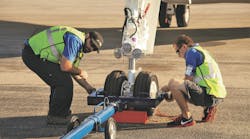BIZAV FORECAST
A softer, but still strong, market seen
By Richard Aboulafia, Director-Aviation, Teal Group Corporation
June 2000
After spending three decades as a small afterthought to the commercial aviation market, the business jet industry has experienced unprecedented growth, tripling in value between 1995 and 2000. Better still, doubts about this growth creating a bubble effect have given way to confidence that the market will stay at a much higher level.
OVERVIEW
• We forecast production of 6,437 business jets worth $78.3 billion (in
2000 dollars) over the next ten years. Over 45 percent of these will be
high-end models. Current years represent an all-time peak, and a decline
will begin in 2001.
• The good times are largely the result of an unprecedented number of
new models, a "near supply push" phenomenon that combines with
fractional ownership to create a lot of up-front orders, but is not sustainable.
• Still, this is a market to be in, thanks in part to the broader "energizer
bunny" U.S. economy and its "cult of productivity." The
worst years of our forecast period will be better than any year before
1998.
• Comparing the forecasted numbers with the previous ten years — when
only 3,716 jets worth $45.6 billion were delivered — the market has grown
by about 60 percent.
• Margins in this segment of the aviation industry tend to be higher than
other segments, although this may change as business jets become less
elite and more of a commodity.
• Thanks partly to its status as a well-funded Canadian company, Bombardier
will be number one in the market with 26 percent, followed by Gulfstream,
Cessna, and Dassault.
• An unprecedented 15 new business jet models arrived in 1995-1999. The
aggregate unit value of these new models is especially high. This wave
of new models will not be repeated for a long time. These new models are
largely the result of new engines, and there are no revolutionary engines
or other technologies on the horizon.
• The first impact of the market upturn has been to increase the value
of companies that are established in the market. This explains General
Dynamics' willingness to buy Gulfstream for $5.3 billion, more than twice
Gulfstream's 1998 sales, in May 1999.
MILD DOWNTURN,
AND THEN ...
Right now, the business jet manufacturing industries' biggest problems
concern production and completion deliveries. Large backlogs and high
demand rates have made getting out the door difficult.
The downside to all of the recent good news is that mature markets that triple in a few years never stay tripled. Already, we see signs of a market softening. The fleet of available used planes is increasing, and prices paid for these planes is plateauing, if not shrinking. There are good reasons to expect 2000 to be the high point of the market. A lot of the catalyst for market growth has been fractional ownership companies, rushing to purchase large numbers of new models. This is effectively a first equipment cycle. In a year or two, it will end.
But the fundamentals are in place for long-term market growth. This is a much broader clientele; and, the evidence is fractionals really do grow the market. Also, as of 1999, the total number of flight departments continues to increase, even counting each fractional provider as only one department. According to AvData of Wichita, KS, there were 8,430 flight departments in the U.S. as of March, 1999 — up from 7,126 in late 1995.
Retirements may also play a role. The first business jets arrived in the early 1960s, and most are still in service. Some 25 percent of the world's business jets are over 20 years old. There could be some major increases in new, or at least newer used, business jet demand after 2002-2005 to replace aircraft retiring from the market.
As a result of the positive market trends, even though there is a market downturn ahead, the business jet market has arrived at a new level. Yet, the biggest potential impact of the transformation of the business jet market concerns profitability. The market no longer caters exclusively to an elite, price-insensitive clientele. Increasingly, it is offering a commodity, complete with price competition. We expect margins to retreat somewhat, and Raytheon Aircraft's recent mediocre results might just be a harbinger of things to come. The question of industry profitability is greatly complicated, again by the question of fractional ownership.
IMPACT OF FRACTIONALS
Fractional ownership firm holdings will soon account for about 10 percent
of the worldwide business jet fleet; this may rise to 15 percent or even
25 percent. We have no way of forecasting this. Right now, deliveries
of new jets to fractionals are running at 15 percent (96 of 636 units,
1999).
Today, there is only one true independent, large fractional ownership player — EJA. The other large concerns, Raytheon's Travel Air and Bombardier's FlexJet, are tied to manufacturers and only order planes from those manufacturers. They may be more about asset management and market share manipulation.
There is also certain to be a cost to manufacturers from fractionals. Any kind of concentration of market power in buyers will increase their ability to negotiate lower prices. Fractional ownership will also have an impact on market cyclicality. We don't know enough about how the mature industry will behave during inevitable market cycles.
Last, because fractional ownership companies emphasize greater utilization of aircraft, residual values may suffer.
What Others Say
...
For other opinions, there are several good places to look: Forecast International;
Honeywell; John Walsh of Walsh Aviation; and, Pratt & Whitney Canada.
• Forecast Int'l: 2000-2009 numbers call for 5,600 jets, with a total
market for 10,000 business aircraft worth $85 billion.
• Honeywell's (formerly Allied-Signal's) Business Aviation Market Outlook
calls for 6,500 jet-powered business aircraft worth $78 billion, delivered
from 1999 through 2009.
• John Walsh forecasts 5,007 business jets for 2000-2009.
• Pratt & Whitney forcasts demand for 6,332 business jets for 2000-2009.
— R.A.




